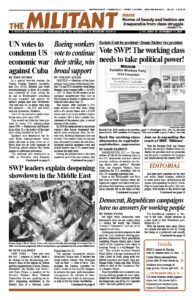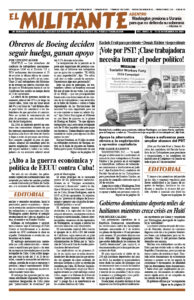While Joseph Biden administration officials and boosters of Kamala Harris’ campaign insist the battle against inflation has been won, working people know from real life experience it just isn’t true. High prices on food, energy, housing, health care and just about everything else workers need are far higher than they used to be. Over the past four years prices have soared at least 20%, and they’re not coming down.
“When you get to the cash register” to pay for your groceries, Christian Cook, an internet technician in Leland, North Carolina, told the Wall Street Journal, “I didn’t really get a whole lot here and it’s still over $100.”
It’s the same story for Jeff Harvey in Erie, Pennsylvania, who lost his job at a boat-supply store in September while his wife, Karen Harvey, took a pay cut at the car-service place where she works. “It’s extremely painful, because I know what things used to be,” she told the paper.
“Why has your Big Mac become so much more expensive?” posed the Financial Times Oct. 16. Because of what it called “cheapflation.” The prices of inexpensive items have risen faster than more costly products, hitting those with the least money the hardest.
You can see this in a big way in relation to higher rents and home mortgages, which many young people wanting to move out of their parents’ homes and raise a family simply can’t afford. In mid-2014 the average home price was $288,000. Today it’s $426,800, a 48.2% increase!
For the wealthy and their upper-middle-class hangers-on who make big bucks off investments in stocks, hedge funds and other speculative endeavors, home prices and expensive upgrades aren’t an obstacle. Those living in multimillion-dollar mountain homes in Telluride, Colorado, 10,500 feet above sea level, spend hundreds of thousands of dollars to install special oxygenation systems in their bevy of bedrooms to assure everyone can sleep comfy.
Kevin Rost, the retired boss of a pipefitting company, spent $18 million on construction of his home equipped with oxygenation units. “People spend a lot of money on their homes in the mountains,” said Adams Roberts, chief operating officer at Altitude Solutions in Colorado, the company that installed Rost’s roof. “But what’s the point if you can’t enjoy it?”
Oh, Rost also had a gondola installed to get him and his guests up and down from the mountain when it snows.
For these people, thinking about prices is worlds away from what working people face.
The Biden administration points to “strong” consumer retail sales as a sign the economy is doing great. But, as The Associated Press admitted Oct. 18, “wealthier Americans are driving retail spending.”
Soaring credit-card debt
For working-class households taking in less than $60,000 a year, spending on consumer goods has declined since mid-2021. To cover costs they’re having to put more of their purchases on credit cards, which piles up debt fast from exorbitant interest rates.
The average annual credit-card interest rate was 21.5% in May. Some cards, like those issued by Synchrony, charge 34.99%. The average balance that people carry on their cards has climbed to around $6,300 today, up 31% from 2021, totaling at least $1,350 in interest payments a year. And credit-card holders get stuck with some $14 billion a year in late fees.
While we have to count our pennies, these bankers are making out like, well, bandits. JP Morgan reports its take from credit cards rose 14%, to $6 billion in the second quarter alone.
There are signs that the economy is slowing. Warehouse and other industrial construction is down 43% from last year, its steepest drop since 2008. Bosses at storage and distribution centers have slashed jobs by 171,600 over the past two years.
Manufacturing has also been slowing, with declines in August for appliances, heavy-duty trucks, machinery and oil extraction.

